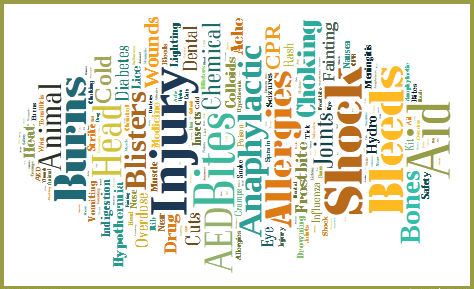
Contents
First aid : Chemical burns
Chemical Burns Overview
A chemical burn is irritation and destruction of human tissue caused by exposure to a chemical, usually by direct contact with the chemical or its fumes. Chemical burns can occur in the home, at work or school, or as a result of accident or assault. Although few people in the United States die after contact with chemicals in the home, many substances common in both living and storage areas can do serious harm.
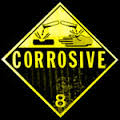
Many chemical burns occur accidentally through misuse of products such as those for hair, skin, and nail care. Although injuries do occur at home, the risk of sustaining a chemical burn is much greater in the workplace, especially in businesses and manufacturing plants that use large quantities of chemicals.
Most chemical burns are caused by either strong acids or strong bases (for example, hydrochloric acid or sodium hydroxide). Acids damage and kill cells by coagulating cells while bases liquefy cells. Prolonged exposure can severely damage human tissues and, if the patient survives, leads to scarring and disability. Other chemicals like oxidants and certain metals may also produce similar chemical burns. Limiting the time of exposure to any of these chemicals can greatly reduce their damaging effects.
Chemical Burn Causes
Most chemicals that cause burns are either strong acids or bases. A glance at the medical information on the labels of dangerous chemicals usually confirms the expected toxicity. Common sense precautions and consumer education can reduce the risk of injury. A variety of common household products that may cause chemical burns are as follows:
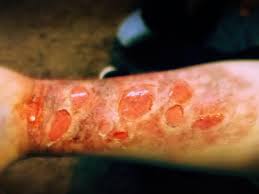
- Bleach
- Concrete mix
- Drain or toilet bowl cleaners
- Metal cleaners
- Pool chlorinates
Chemical Burn Symptoms
All chemical burns should be considered potential medical emergencies.
Most chemical burns occur on the face, eyes, hands, arms, and legs. Usually a chemical burn will be relatively small and will require only outpatient treatment. Chemical burns can be deceiving, however. Some agents can cause deep tissue damage that is not not readily apparent when people first look at it.
Tissue damage from chemical burns depends on several factors.
- The strength or concentration of the agent
- The site of contact (eye, skin, mucous membrane)
- Whether swallowed or inhaled
- Whether or not skin is intact
- With the quantity of the chemical
- The duration of exposure
- How the chemical works
- The length of time to washing (decontamination)
Signs and symptoms of chemical burns include the following:
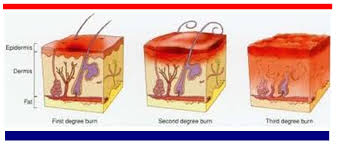
- Redness, irritation, or burning at the site of contact
- Pain or numbness at the site of contact
- Formation of blisters or black dead skin at the contact site
- Vision changes if the chemical gets into the eyes
- Cough or shortness of breath
- Vomiting
In severe cases, a person may develop any of the following symptoms:
- Low blood pressure
- Faintness, weakness, dizziness
- Shortness of breath or severe cough
- Headache
- Muscle twitching or seizures
- Cardiac arrest or irregular heartbeat
When to Seek Medical Care
Once all immediate danger has passed and the person has completed basic first aid (removed from the chemical source, contaminated clothing removed, and, if skin or eyes involved, extensive rinsing with water in most situations), a doctor, if immediately available, should review the injury and the chemical involved to make sure the patient needs no further emergency treatment. If a potential problem remains, the doctor can arrange appropriate treatment or will direct the patient to go to a hospital’s Emergency Department.
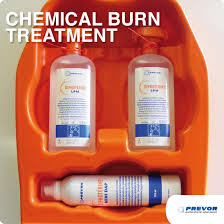
Emergency personnel are trained to assess the extent of a chemical burn, begin treatment, and transport victims to the most appropriate hospital.
Emergency officials also may determine the need for more involved decontamination of both the patient and the accident site prior to going to the hospital. It is possible that the patient needs further decontamination before arriving at the hospital. As much of the following information as possible needs to be related to the call dispatcher:
- Number and location of the injured person or people
- Mechanism or nature of injury (how it happened)
- Whether emergency personnel can reach the victims (are victims trapped?)
- Name, strength, and volume or quantity of the chemical causing the burn (give a container or its label of the chemical to emergency personnel, if possible)
- Length of time of contact with the chemical
Chemical Burn Treatment
Most people with minor chemical burns do not need to be admitted. Most can go home after arranging follow-up care with a doctor. Patients with major chemical burns however, need to be admitted to a hospital. Ingestion or inhalation of chemical burns may need to be admitted for observation, depending on the potential severity of tissue damage.
Chemical Burns Self-Care at Home
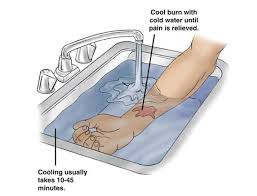
Begin basic first aid. Immediately call emergency number if a person has a severe injury, any shortness of breath,chest pain, dizziness, or other symptoms throughout the body. If are aiding an injured person with these symptoms, lay the person down and immediately call emergency number. Protect yourself and make sure that you are not exposing yourself to the same chemical.
- Remove yourself or the injured person from the accident or exposure area. Take appropriate care not to cause further injury to the patient.
- Remove any contaminated clothing.
- Wash the injured area to dilute or remove the substance, using large volumes of water. Wash for at least 20 minutes, taking care not to allow runoff to contact unaffected parts of anyone’s body. Gently brush away any solid materials, again avoiding unaffected body surfaces.
- Especially wash away any chemical in the eyes. Sometimes the best way to get large amounts of water to the eyes is to take a shower. If there is an eye wash station nearby (usually fond at work sites), follow the simple instructions to rinse out the eyes.
Rinse and Clear Burn Area
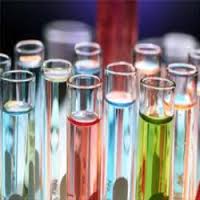
- Flood area with cool water for at least 20 minutes or until help arrives.
- Make sure water doesn’t flow onto another part of the person’s body or onto you.
- Don’t use a strong stream of water, if possible.
- As you flush the burn (not before), remove jewelry or articles of clothing with chemical on them, unless they’re stuck to the person’s body.
- After flushing the burn, follow instructions on the label of the chemical product, if available.
- Don’t try to neutralize the burn with acid or alkali. This could cause a chemical reaction that worsens the burn.
- Don’t put antibiotic ointment on the burn.
Chemical burn of the skin
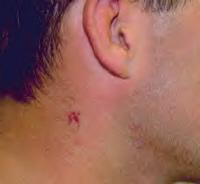
Chemical burn of the eye
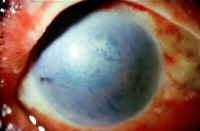
First aid video for chemical burn
First aid video for chemical burns
